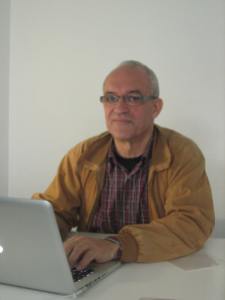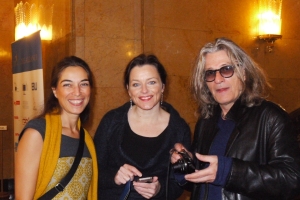Bård Kjøge Rønning and Fabien Greenberg (Directors/Producers)
Interview by Dimitra Kouzi
Freedom of speech played out at the street level: A deep dive into the extreme Islam-critical group SIAN (Stop the Islamization of Norway) and the chaos they cause.
‘Norwegian Democrazy’ explores the clash between free speech and hate speech. It follows the controversial Islam-critical group SIAN and their protests, which spark heated debates and require heavy police protection. We see both sides - SIAN's leader and their opponents - as the film probes the future of free speech in a democracy.
1. What motivated you to delve into the subject matter of SIAN (Stop the Islamization of Norway) and its impact on Norwegian society?
Our initial idea was to dig into the history of integration in Norway with an optimistic approach and angle it towards freedom of speech and cultural expression, but we soon grasped the need for more immediate and current material. At the time, the BLM movement was roaring, and SIAN’s demonstrations caused a huge chaos. So, we decided to seek access there and reshuffle our storyboard.
2. Could you describe the process of gaining unique access to SIAN leader Lars Thorsen and his partner Fanny Bråten for the documentary?
We phoned Lars, the leader, and arranged for a first meeting. We laid out our premise and intention, and slowly gained access into the organisation and its core members. They were very skeptical at first, but after each time meeting them they loosened up and let us be present with them almost anywhere, both privately and in the public sphere.
3. In the film, you explore the concept of freedom of speech in relation to SIAN's activities. How do you perceive the boundaries of freedom of speech in such contentious contexts?
Freedom of speech is highly regarded in Norway, which is considered to be one of the “freest” countries in the world. Article 100 in the Norwegian Constitution makes it the responsibility of the State to protect freedom of speech. Since Thorsen’s message, and even the burning of a holy book, is legal, the police must protect him, according to the law. When you regard freedom of speech in that equation, have we gone too far? Are we in fact protecting abuse of freedom of speech? Where do we, as a society, draw a red line? Should we let extreme right wingers roam freely, spreading hate? Are we going from Democracy to Democrazy?
4. The film touches on the parallels between SIAN's rhetoric and the tragic history of right-wing extremism in Norway, particularly the actions of Anders Behring Breivik. How do you navigate the sensitivity of this comparison?
This is indeed sensitive. We have seen what Breivik did, and what certain extremist individuals are capable of. Our main focus was an observational approach to the origin of hate, and how the most heated debate of our time plays out at the street level, a deep dive into how freedom of speech works in turbulent times, and the health of our democracy. We were definitely aware of the Breivik parallel, and it scared us, but we tried to stick to our focus and goals with the documentary.
5. Axel, a young counter-demonstrator, is one of the main characters in your film. What drew you to follow his story, and what insights did you gain from his perspective?
We certainly needed a dramaturgical and narrative counterweight to SIAN. Axel is a bright and brave young man who, after thinking it through, chose to be part of the film, and we are very happy for that. Axel was also perfect because he is a liberal leftist with a very open mind and cognitive horizon.
6. Can you discuss the challenges you faced while filming scenes of SIAN's rallies and demonstrations, considering the potential for confrontation and violence?
Oh yes! It was unpleasant and hectic at times. Tear gas, fences being thrown, punches given. And a lot of eyes were on us, being up there, with them, filming. For us, moving from the SIAN stand to the crowd of young counter-demonstrators, and back to the SIAN stand, we had to move and behave in a very low key and keep a low profile, but also boldly when needed.
7. SIAN's activities have been described as racist and provocative by many. How did you approach portraying their ideology and actions while maintaining journalistic integrity?
We do mostly observational documentaries. In the case of “Norwegian Democrazy,” we weren’t sure if we could do it without doing interviews or engaging in critical dialogue with the main characters. But we chose to go for it, because we believed it would make a truer and deeper film. We did numerous interviews with lawyers, supreme court judges, politicians, and experts, but chose not to use them. We would risk to lose the immediate dramatic feeling in the film. The editing process, with Linn Heidi Slåttøy, was very helpful, in terms of making ethical choices with time and thorough thinking.
8. What do you hope viewers will take away from "Norwegian Democrazy" regarding the current state of democracy and freedom of speech in Norway and beyond?
We hope the audience leaves the cinemas eager to discuss and engage in debate. Democracy means so many different things. At a time where democracy declines in many countries, we want to foster an open debate that can give people a deeper understanding of democracy’s pillars and the risks it’s facing.
9. You have described the film as offering a "rough rollercoaster ride" experience for viewers. How did you balance the emotional impact with the need to convey complex political and social issues?
We gave it a lot of thought during the editing process. Here, we wanted to make the cinematic experience strong and intense, to create emotional impact. We also tried to be notoriously tidy with laws and paragraphs, and precise with our indirect gaze towards these topics.
10. As directors, what ethical considerations did you prioritise when making decisions about how to present sensitive topics like hate and racism in Europe?
We wanted to do it up close, on the street level, for the intensity and realness of it, because we wanted to make a good film, with a strong impact. There were many elements of doubt on the ethical side: privacy, young people, possible threats, and so on. The blurring is a measure we took in this regard. We also have tens of good scenes that we cut out, due to an image or content that could possibly be harmful or dangerous for someone.
11. "Norwegian Democrazy" has received critical acclaim and has been showcased at prestigious film festivals. How do you anticipate its reception internationally, particularly in regions where similar extremist movements exist?
We hope the film creates a debate on freedom of speech that is open and healthy. We want to create a debate on hate, on racism, on prejudice, on how a modern state deals with all this. We do believe its reception will be mainly positive, but it will for sure spark controversy and be criticised, as well. We have felt it in the Q & A’s, lots of hands in the audience going up in the air – like in a heated classroom.
12. What role does documentary filmmaking play in fostering understanding and dialogue around contentious issues like those explored in "Norwegian Democrazy"?
We believe the documentary is becoming increasingly important. Reality is getting distorted in our world: AI, algorithms, fake news, social media, people read much less, woke/anti-woke, and so on… A good documentary has a topical quality about it, which is solid and indispensable. A good documentary shows; it doesn’t tell. A good documentary has the possibility to change people and their behaviour – that is our motivation with every film, to make a change somehow. Let’s see how it goes this time.
PREMIERES
International Premiere: HotDocs, Toronto, 2 May 2024 (selected for THE CHANGING FACE OF EUROPE)
European Premiere: DokFest Munich, 6 May 2024
Norwegian Premiere: Human IDFF, 5 March 2024
Sales and distribution
Acquisitions l Journeyman Pictures l T: +44 (0)2087866050 l M +44(0)7789381184
https://www.journeyman.tv/film/8642
FESTIVAL DISTRIBUTION & SALES AGENT
Festival Distribution Norwegian Film Institute
Festival Contact Elisabeth Aalmo, Norwegian Film Institute
+47 932 66 554






